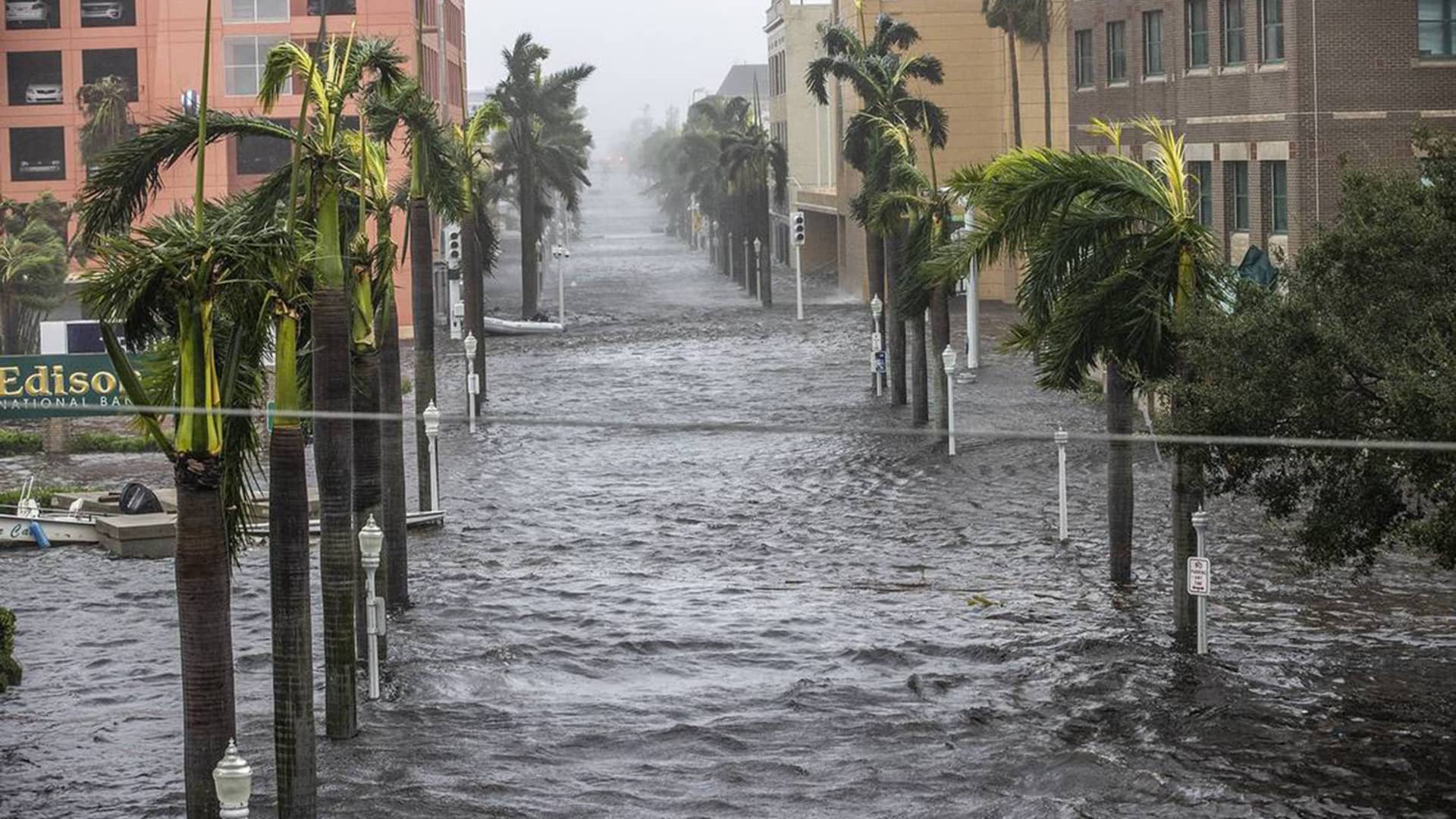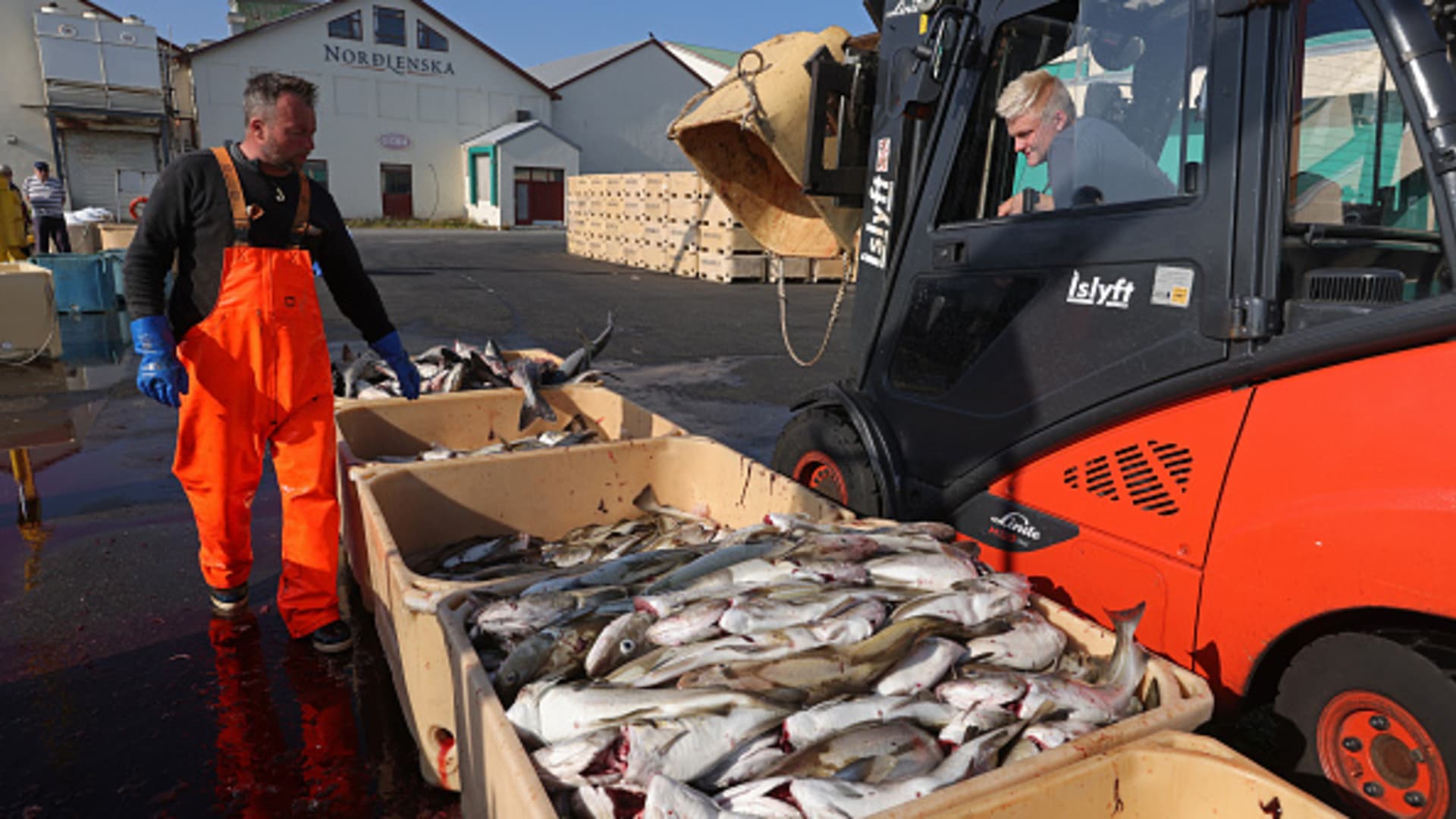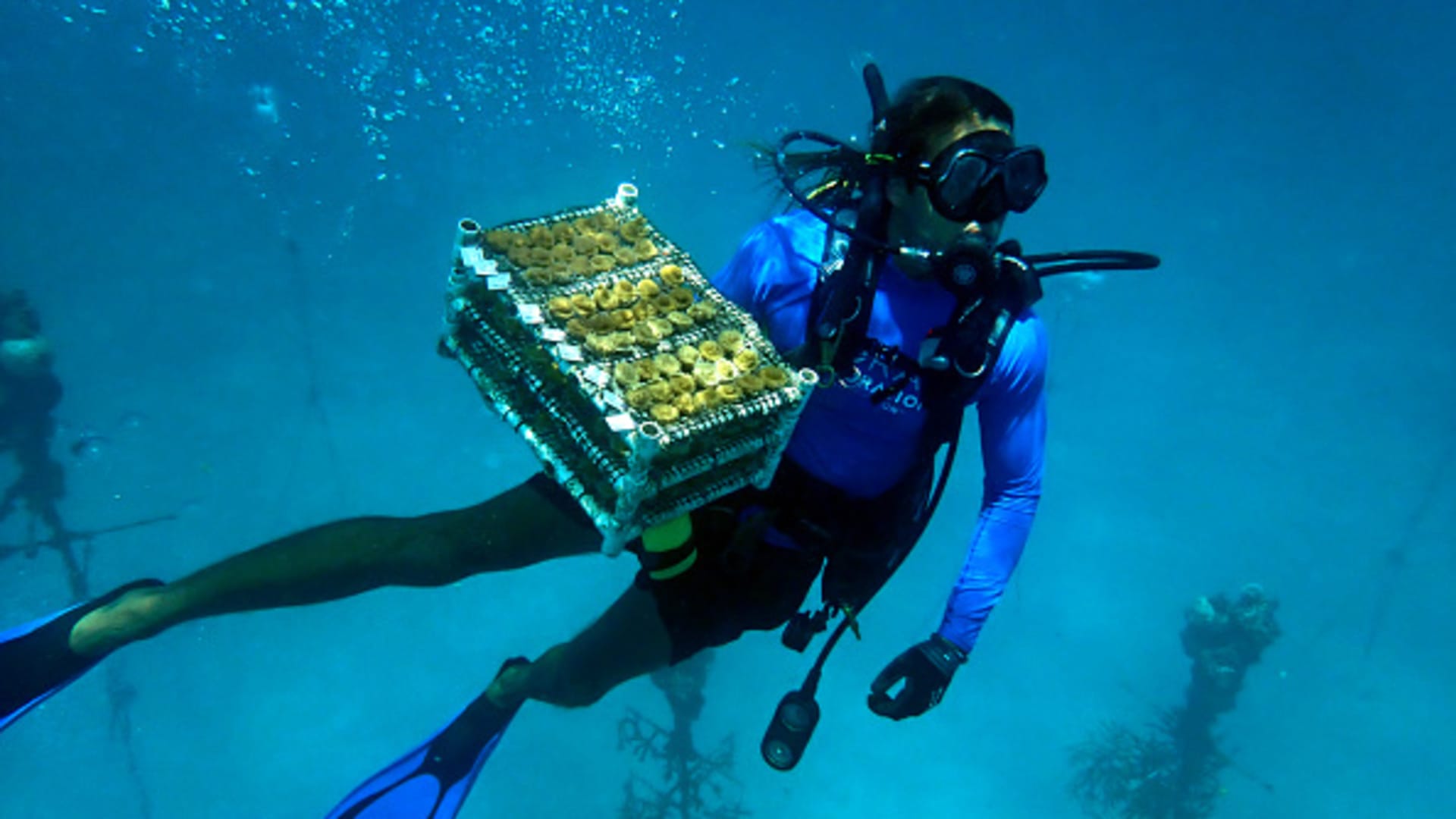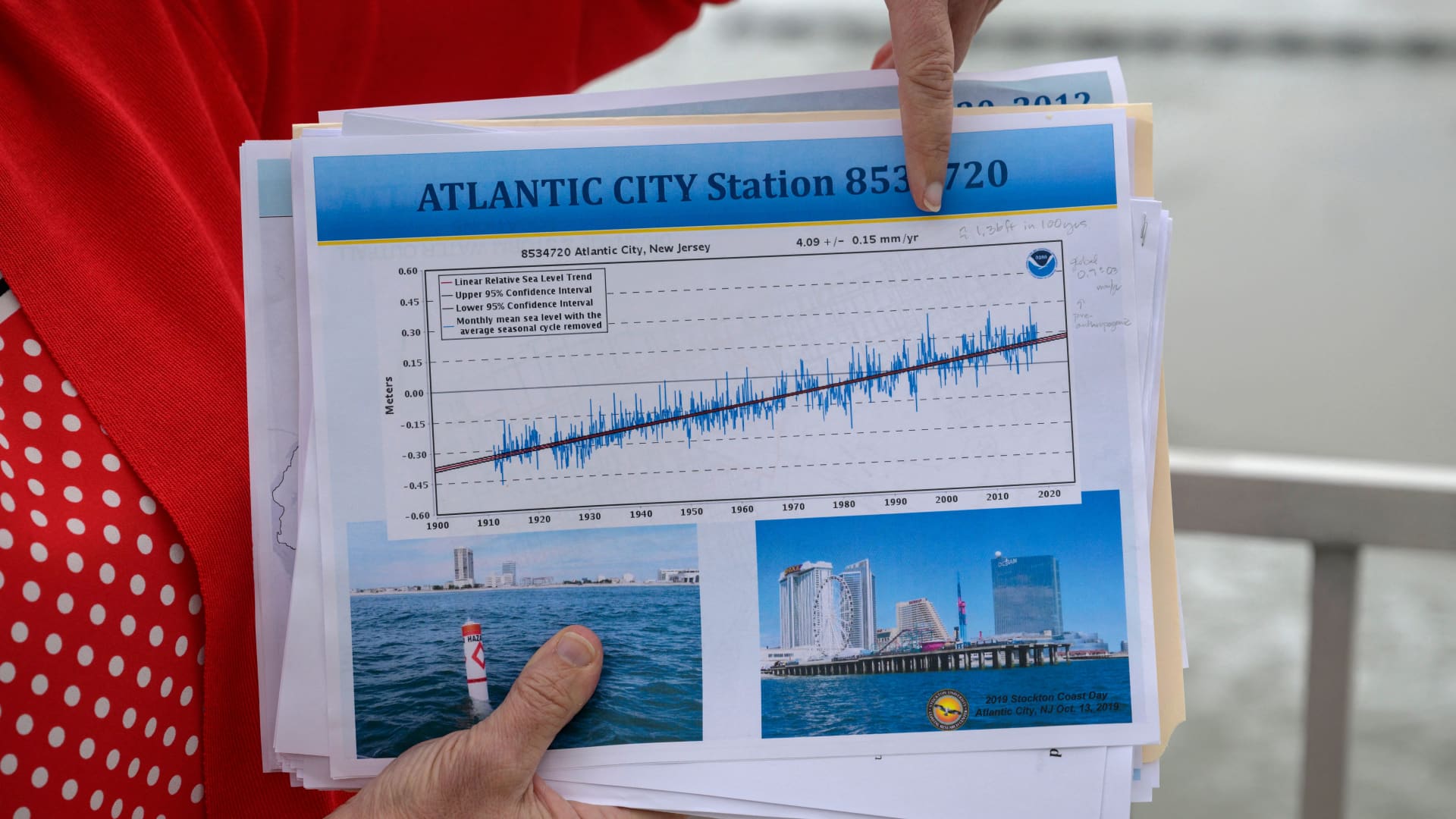
- Oceans absorb more than 90% of the excess heat caused by climate change.
- Oceans are hitting record high temperatures. The global average sea surface temperature hit an all-time record high of 69.73 degrees Fahrenheit on July 31, according to a data set maintained by Copernicus, the the Earth observation component of the European Union's Space program, which goes back as far as 1979.
- Record ocean temperatures cause stronger storms, displace and kill fish populations, stress coral reef populations, turbocharge the growth of harmful algal blooms and in the long-term, cause sea level rise.
The oceans of the world absorb the overwhelming majority of the heat caused by global warming, creating serious consequences for life in and around them, including humans.
"The oceans do a lot of the work in reducing the level of warming," Baylor Fox-Kemper, professor of earth, environmental, and planetary sciences at Brown University, told CNBC. "Over 90 percent of the excess energy on earth due to climate change is found in warmer oceans, some of it in surface oceans and some at depth."
The oceans cover 70% of the earth's surface, and water can absorb tremendous amounts of energy.
Get Southern California news, weather forecasts and entertainment stories to your inbox. Sign up for NBC LA newsletters.
"Water has a huge heat capacity, which means that it takes a lot of energy to change the temperature of water," Carlos E. Del Castillo, head of NASA's Ocean Ecology Laboratory, told CNBC. "Do the mental experiment. Put two pots on a stove. One with water, one without. Both on high. Wait one minute. If you touch the water, you will barely feel a difference in temperature. If you touch the metal of the empty pot you will burn. This is because the heat capacity of water is way higher that that of a metal." Castillo admitted the science is a bit more complicated that this mental thought exercise, but it helps visualize the idea of heat capacity.
That shows "why a small change in temperature in the ocean" means the oceans have been absorbing massive quantities of heat, Castillo said.
Record temperatures of 101 degrees in the ocean off the coast of Florida is one more example of the increasingly obvious effects of climate change. NASA on Monday said July was the warmest month in its record books dating back to 1880.
Money Report
"The warmer ocean that we are seeing now represents a ratcheting up of the climate change signal," Benjamin Kirtman, professor of atmospheric sciences at the University of Miami, told CNBC. "This is consistent with a continued increase in extreme weather in the climate system, that is more heat waves and marine heat waves, droughts in already dry regions, floods in already wet areas, extreme winds, and fire."
The more greenhouse gasses we emit, the hotter the oceans will get.
"Greenhouse gas warm the entire climate system including the ocean. Put simply, the greenhouse gases serve to trap more heat, some of which is absorbed by the ocean," Kirtman told CNBC. "So, as greenhouse gas concentrations increase, we expect the ocean to absorb more heat and warm."
By the numbers: Record highs and big-picture trends

The global average sea surface temperature hit an all-time record high of 69.73 degrees Fahrenheit on July 31, according to a data set maintained by Copernicus, the the Earth observation component of the European Union's Space program, which goes back as far as 1979. This particular data set measures temperatures at about 33 feet below the surface of the ocean.
"Global" in this data set is defined as the oceans beyond the polar region, between 60 degrees latitude south and north. Measuring sea surface temperatures in this extrapolar region is considered standard for climate monitoring, but the sea surface temperature among all ice-free oceans also reached a record-high level in July, Copernicus said.
The previous record was set in March 2016 — March is the time of year when oceans in the southern hemisphere get warmest, and because the southern hemisphere has more ocean it tends to be the hottest peak of the year, Gavin Schmidt, director of the NASA Goddard Institute for Space Studies, told CNBC.
In addition to the daily record on July 31, the monthly sea surface temperature for July was the hottest July on record, "by far," Copernicus said. The anomaly for July, which is a measurement of the difference between what the sea surface temperature was and a long-term average for that month, was 0.92 degrees Fahrenheit, according to Copernicus.

These record sea surface temperatures arise from multiple factors, including the El Niño weather pattern, which is currently in effect. "The particularly warm waters this year have to do with climate variations like El Niño in the Pacific and a similar pattern in the Atlantic on top of the steady ocean warming of climate change," Fox-Kemper told CNBC.
"These climate variations occur when sea surface temperature patterns of warming and cooling self-reinforce by changing patterns of winds and precipitation that deepen the sea surface temperature changes."
But global warming is also contributing. "It would be nearly impossible to reach these ocean temperatures without the added boost of greenhouse gasses from fossil fuel burning and other human activities," Fox-Kemper told CNBC.
Human-caused greenhouse gas emissions are adding the equivalent of a permanent El Niño worth of heat to the climate every five to ten years, Zeke Hausfather, energy systems analyst and data scientist with a strong interest in climate science and policy and a research scientist at Berkeley Earth, told CNBC.
The recent bout of record-breaking sea surface temperatures are part of a long-term trend. "The last 10 years have been the warmest since at least the 1880s for sea surface temperature," Castillo told CNBC.
Currently, 44 percent of the global ocean is experiencing what's called a "marine heatwave," according to Sarah Kapnick, chief scientist at the National Oceanic Atmospheric Administration. That's the highest percentage of the global ocean experiencing a marine heatwave since 1991, Kapnick told CNBC via a spokesperson. A marine heatwave is defined as when the ocean temperatures are higher than 90% of the previous observations for that region at that time of year, according to NOAA.
So why does it matter that the oceans are getting hotter?
Warmer oceans make stronger storms
"The most powerful storms on earth — hurricanes and tropical and extratropical cyclones — extract much of their energy from warm, moist air near the ocean surface. Hotter seawater means warmer and moister air, which then has more energy to release leading to stronger storms," Fox-Kemper told CNBC.
This explains why the most prevalent paths for strong storms follow warm ocean currents like the Gulf Stream and Kuroshio in the Northern Hemisphere, Fox-Kempler said.

Evaporation of water vapor from the ocean surface, which makes the moist air that drives the stronger storms, is a factor of ocean temperatures and wind speed, and the impact of ocean temperature on that equation is "highly non-linear," Kirtman told CNBC, meaning that small changes in temperature lead to large increases in evaporation. When water vapor condenses, it releases heat into the atmosphere, which starts a positive feedback loop. "So, if the atmosphere is more moist, there is more condensational heating which intensifies the storm," he said.
The impact of the warming sea waters on hurricane development varies depending on what region of the ocean sees the highest increase in temperature, Michael Lowry, a hurricane specialist and storm surge expert, told CNBC. The ocean temperatures in the main development region for hurricanes, like the deep tropical Atlantic south of the 20 degrees latitude, are especially critical.
"This is what seasonal hurricane outlooks like those issued by NOAA last week are keying in on," Lowry told CNBC, referring to a hurricane forecast outlook where NOAA said the warming oceans would boost hurricane activity for the remainder of the season.
But wherever a hurricane forms, the hot oceans will strengthen it. "The extreme sea surface temperature is like dry powder when storms get going. As we say in this business, it only takes one," Lowry said.
Fish populations will migrate or die
Fish populations depend on specific temperatures.
"All species have a preferred and a lethal temperature range. Once the upper border of the preferred temperature range is reached, they go deeper or pole-ward to cooler waters, if they can," Rainer Froese, senior scientist at the Helmholtz Centre for Ocean Research in Germany told CNBC. "Already at the upper tolerance range, growth and reproduction are hampered. At the upper lethal range, they die."
Fish will migrate towards colder waters, if they can. Fish that lived in Florida will be found in New York waters, and fish that lived in New York waters will migrate to Nova Scotia, according to Daniel Pauly, professor at the University of British Columbia's Institute for the Oceans and Fisheries. "Individuals are found, especially in the summertime, to reach areas that they never reach before," Pauly told CNBC.

Warmer sea water is dangerous for fish for two reasons: "Warmer water contains less oxygen than cold water, but the metabolic oxygen demand of fish is higher in warm water," Lorenz Hauser, professor at the School of Aquatic and Fishery Sciences in Seattle, told CNBC.
"Fish metabolism depends very much on water temperature, and with warmer water, fish need more food to maintain their bodies and grow," Hauser told CNBC. "On the other hand, ecosystems change with warmer water, and there may not be sufficient prey around. This was the case with the recent stock collapse of Pacific cod in Alaska."
While fish may have a chance to migrate if sea water changes are gradual, in a sudden ocean temperature increase like a heatwave, the fish will die, Pauly told CNBC. This is particularly true for larger fish because the surface of the gills on a fish do not grow as fast as the total weight. The bigger fish have less gill area per unit of weight in the same species, Pauly said.
"In the future, we will see massive changes in regional species composition, and lots of die-offs where species cannot escape fast enough, or where they fall prey to predators or are out-competed by species that they have not encountered before," Froese told CNBC.
Coral reefs are dying
Coral reef populations are getting ravaged by the hot ocean temperatures. The Coral Restoration Foundation, a nonprofit coral reef restoration organization headquartered in Florida, has been taking corals out of the ocean and putting them in land-based holding tanks.
"On July 20th, Coral Restoration Foundation teams visited Sombrero Reef, a restoration site we've been working at for over a decade. What we found was unimaginable — 100% coral mortality," Phanor Montoya-Maya, Restoration Program Manager at Coral Restoration Foundation, said in written statement in July. "We have also lost almost all the corals in the Looe Key Nursery in the Lower Keys."

Coral reefs thrive in ocean temperatures between 73 and 84 degrees Fahrenheit, but they can survive in both higher and lower temperatures for short periods of time, Castillo told CNBC. But the hot ocean temperatures in Florida have caused "wide-spread coral bleaching," Castillo said. Coral bleaching happens when the over stressed corals expel zooxanthellae, an algae that they need to survive.
"Although coral can survive bleaching and re-grow their zooxanthellae, these bleaching events debilitate the coral. In the case of the recent heat wave, outright coral die off were reported," Castillo told CNBC.
Coral reefs are critical to the marine ecosystems. About a quarter of marine species depend on the coral reefs in some capacity, Castillo said.
More dangerous algae blooms
"Microorganisms like it hot," Hans W. Paerl, professor of marine and environmental sciences at the University of North Carolina at Chapel Hill's Institute of Marine Sciences, told CNBC. "The higher the temperature and the faster they grow, and so this really has been a boon to them."
The organisms that can grow really quickly in hot ocean temperatures and cause harmful algae blooms include dinoflagellates and diatoms, which are also called sometimes called microalgae or red tide, and cyanobacteria, which is sometimes called blue-green algae.

Both people and animals can get sick by being exposed to these algal blooms or eating seafood contaminated with them. The severity of the sickness depends on type of algae and how long exposure lasted, according to the Centers for Disease Control and Prevention.
Algal blooms can become more intense when nitrogen and phosphorus in fertilizer runoff gets to oceans, and climate change is impacting the pace and cadence of fertilizer runoff because of the increasing severity of both rain storms and dry spells.
"When you have a major storm, it's going to pick up more nutrients from the land and flush them into our coastal and ocean systems," Paerl told CNBC. "If a wet period is followed by an extensive drought, then you actually enhance the growth for some of these organisms, because they like stagnant, dry conditions, as well."
The combination of hotter waters and more fertilizer runoff will drive the algae and bacteria growth and respiration, which creates low oxygen zones that impacts fish populations and can in some instances cause "dead zones," Paerl told CNBC. "That, of course, has huge implications for the food web, and ultimately for us, in terms of consumers of fish and shellfish."
As the oceans warm, the blooms themselves are migrating to cooler waters where they'd never been seen before, says Christopher Gobler, professor at Stony Brooke University's School of Marine and Atmospheric Sciences who researches Coastal ecosystem ecology, climate change, harmful algal blooms.
"Harmful algal blooms that may have never had a chance to form in the past have become dense and widespread in regions such as Alaska and northern Europe," Gobler told CNBC. "This is highly problematic as these new occurrences can take ecosystems and communities by surprise, exposing marine life and, in some cases humans, to toxins that were regionally unknown, causing mass mortalities and/or illnesses."
Long-term: Sea level rise
"Water expands as it gets warmer," Gary Griggs, professor of earth and planetary sciences at the University of California in Santa Cruz, told CNBC.

So broadly speaking, warmer oceans will lead to sea level rise and coastal flooding risk. "As the ocean warms it expands, much like a gas, and takes up more space, hence sea level rise. Warmer oceans in the higher latitudes means less sea ice which allows the oceans to warm further," Kirtman told CNBC. "This is known as a positive feedback."
Generally, about two-thirds of global sea level rise is caused by ice melt from Antarctica, Greenland and continental glaciers and the other one-third from "overall temperature increase," Griggs said. But also, the recent trend in record-high sea surface temperatures aren't enough on their own to cause any noticeable changes in sea level, Griggs noted.
"Any large-scale increase in ocean water temperature increases sea level and the amount can be determined if you know the total volume of water affected and the amount of temperature increase by using the coefficient of thermal expansion," Griggs told CNBC. But there are approximately 330 million cubic miles of sea water, and it takes "a lot of heat to substantially increase sea level rise."
Economic impacts and looking ahead
Right now, it's really too soon to measure the economic impact of these record sea surface temperatures, Judith Kildow, founder and director emeritus of the National Ocean Economics Program, told CNBC. Years of more data are needed. In some cases, people who depend on the oceans for their livelihood are adapting, Kildow said. "Fishermen are turning their boats into whale watching enterprises when they no longer can fish profitably," Kildow told CNBC.
But there will be cascading economic impacts. "Bleached coral reefs, rising sea levels from warming, and migration of fisheries north to their normal temperatures will have an effect on the fishing industry and coastal tourism as well as the value of coastal real estate," Kildow told CNBC. AStronger storms, driven by warming ocean waters, will cause more devastating and expensive damage if they make landfall. "Value of costal real estate will drop precipitously in a short period of time," Kildow said.
If it sounds like a lot of bleak news, it is. Asked if there were any benefits to the warming oceans, Schmidt from NASA responded: "Slightly extended beach swimming period?"
The best way to ameliorate the whole cornucopia of negative impacts is to reduce greenhouse gas emissions.
"Of course, the key to all of this is less fossil fuel combustion," Paerl told CNBC. It's also important to reduce the release of other greenhouse gas like methane and nitrogen oxides, he said. "So that's one thing we should all be doing is consuming and burning less fossil fuels."






